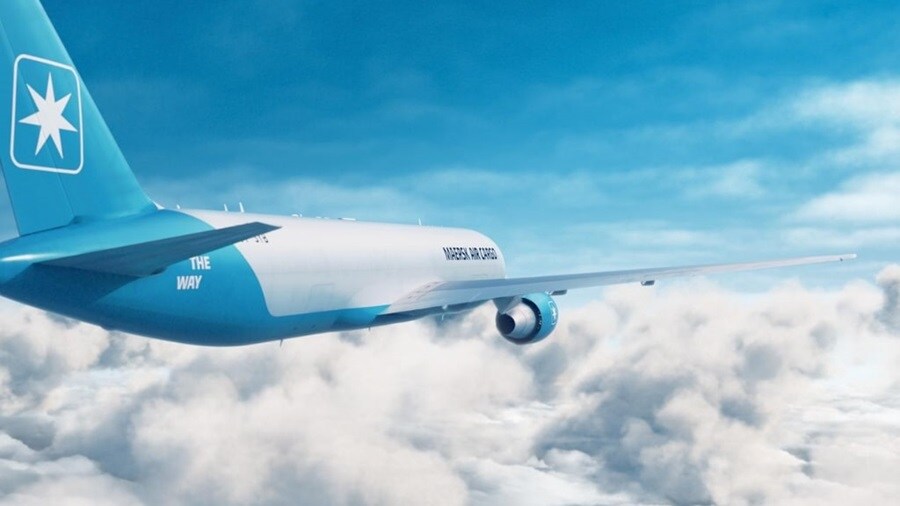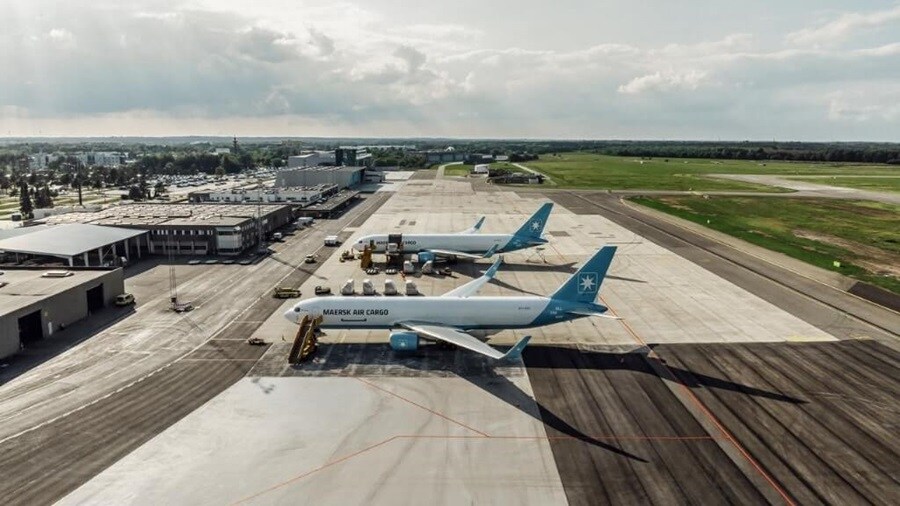You probably know Maersk as an ocean carrier. But, as part of our integrator strategy, we’re making big investments in all modes of transport to provide end-to-end logistics solutions for our customers. Especially air.
But this isn’t necessarily the case throughout the industry. In a recent The Loadstar interview, one industry stakeholder observed: “Air cargo has been under-invested in for more than 40 years.” So, at a time when others are hesitant to invest in air, we’re doing the opposite. We’re going big.
Here are five ways that show how we’re here for the long haul.

#1 Launching our Billund hub
The first place to start is with our home in Billund, Denmark. It’s where our European Air Cargo Hub is headquartered, and the foundations of our air freight strategy have been laid. It’s an ideal location with great road connections to Northern Europe and Scandinavia.
In terms of the facility itself, the hub is home to a fully-equipped 4,000m² import and 13,000m² export facility, as well as separate areas for cold storage, dangerous goods, scanning and unit load device (ULD) handling.
As far as airports go, it’s relatively small. But that’s a huge advantage for our customers because it means there’s less congestion and we can get goods unloaded, processed and on the road faster. Especially as air cargo is often time-sensitive, this gives us a platform to maximise the speed advantage.
The launch of a dedicated hub shows that now that we’re airborne, we’re not coming down.

#2 Ramping up our China-Europe route
One of the key reasons behind launching our European Air Cargo Hub is to help feed high Chinese export demand, setting up a route between Hangzhou International Airport and Billund Airport.
Based on the last available data from the European Commission (2022), China was the largest exporter of goods into the EU (20.8%). That’s huge. While Chinese exports saw a drop in the middle of 2023, they recovered towards the tail end of the year, according to the Financial Times.
From our experience, the demand from China will keep growing. When we launched the Billund Hub in March 2023, we had just two Boeing 767-300 freighters taking off from Hangzhou per week. Since then, the demand from our customers has increased significantly, and we’re now running seven flights on this route per week. We’ve more than doubled our capacity, showing our commitment to air.

#3 Bigger, better aircraft
We’ve looked at facilities and routes, now let’s look at the transport assets.
In addition to our fleet of 20 freighters, we’ve invested in two new Boeing 777F aircrafts, all of which are set to come into operation in 2024.
These newbuild, state-of-the-art aircraft boast a host of advantages. For example, the 777 Freighter is the world’s largest, longest range and most capable twin-engine freighter.
For us, the core benefit is that these aircraft will enable us to further increase our capacity. With the global volume of air freight transport forecast to increase by 14.28% between 2023 and 2028, this investment sets us up in a good position to meet this growing demand.
Maersk is also the only company in the UK licenced to operate a Boeing 767-200.

#4 Rolling out our booking technology
Now to a different part of our integrated logistics offering – technology.
According to McKinsey, less than 40% of an airline’s capacity is booked two weeks before departure.
Given the increasing frequency of black swan events, and air freight’s power to overcome such disruption, this is surprising. You’d think last-minute bookings would account for a much larger share.
It’s not a big leap to suggest that some of the industry’s problems come down to a lack of digitalisation and a clunky booking process. At Maersk, we’re making a conscious effort to change that. We’ve now rolled out our booking platform to air cargo, making it easier for you to place bookings, whether it’s planned in advance or last-minute. Plus, with Maersk instant prices, we provide air freight quotes on 70,000 trade lanes across more than 90 countries, so you get cost visibility upfront.
Air Cargo Week recently reported that: “The air cargo carriers which are investing heavily in technologies… will set the new standard for the entire air cargo industry. ”At Maersk, we’re doing just that.

#5 Investments
Finally, another way we’re showing our commitment to the air freight market is through mergers and acquisitions.
This started with the acquisition of Senator International, in 2022. As a result, we’ve been able to add a heap of value to our air freight capabilities.
Not only has it improved our controlled flight operations, it’s also enhanced our freight forwarding proposition, opened doors to partnerships and opportunities, and injected new skills, expertise and assets.
The acquisition has strengthened our business as a whole and gives us a lot of reasons to be excited about what the future holds.
A clear statement of intent
Whether it’s the investment in facilities, aircraft, routes or expertise, we’ve been busy building out our air freight capabilities and network over the past few years.
It’s a clear statement of intent. The air freight market is growing – and we’re growing with it to best serve our customers. Or, put another way, this is not just a short-term solution; we’re here for the long haul.
To talk to us about how Maersk Air Freight can help your business:
无论您需要什么,我们都可以随时为您提供帮助
I agree to receive logistics related news and marketing updates by email, phone, messaging services (e.g. WhatsApp) and other digital platforms, including but not limited to social media (e.g., LinkedIn) from A. P. Moller-Maersk and its affiliated companies (see latest company overview). I understand that I can opt out of such Maersk communications at any time by clicking the unsubscribe link. To see how we use your personal data, please read our Privacy Notification.
By completing this form, you confirm that you agree to the use of your personal data by Maersk as described in our Privacy Notification.

